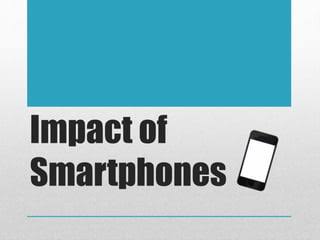What you need to know about the impacts smartphones
The mobile smart phones have turned into the fundamental communication gadget that has altered practices of general, business, and social communications in some ways. Therefore, it cannot be said that the integration of Smartphones into the acknowledge usage is just a plus in terms of the enhanced connectedness; there are benefits and drawbacks defining the new roles and means of communication systems.
1. Ubiquity and Accessibility
Another pertinent implication of carrying a smartphone in one’s pocket is the perpetuating aspect of having resources for communication, and a capacity to have access to them without at least a moment’s delay. This is unlike the initial mobile phones which are chiefly characterized by the communication that encompasses voice and text/Short Messaging Service SMS. This is simply understood as the fact that individuals are able to find some solace in the several forms of communication that exists in some instances.
2. Real-time Communication
Perhaps, the availability of smartphones has contributed to the practice of real-time communication in people’s lives. Applications like WhatsApp, telegram, and iMessage enable the users to send and receive messages within a blink of an eye. It has provided a better course of handling communication than in the past that was taken when meeting communication needs more hence upping the pace of communications. In professional environment this real time communication can be of very valuable since it increases the productivity and effectiveness of organizational and minimum time taken in manoeuvring and solving problems that may arise within the organization.
3. Social Media & Tech-Networking
Consequently, smartphones have become a demand that led to the increased use of social networks, which are regarded as essentials of the current communication. Consequently, through the application of social networks, the users are able to share information such as opinions, events, and feelings with many people, new forms of social relations appear. New generation social sites like face book, twitter, Instagram, linked and many others are virtual community through which an individual can easily speak to his friends and families or make new friends or meet new people.
4. Communication Efficiency and Productivity
The integration of various communication tools into smartphones has streamlined workflows and enhanced productivity. Emails can be checked and responded to on the go, important documents can be shared instantly, and team collaborations can occur seamlessly through apps like Slack, Microsoft Teams, and Trello. This constant connectivity ensures that work can continue irrespective of location, supporting the rise of remote work and flexible working arrangements.
5. Changing Dynamics of Personal Relationships
The impact of smartphones on personal relationships is multifaceted. On one hand, smartphones enable people to stay connected with loved ones across distances, fostering a sense of closeness and continuity in relationships. Regular communication through calls, messages, and social media helps maintain bonds and offers emotional support, particularly in long-distance relationships.
6. Cultural and Behavioral Shifts
Smartphones have not only changed how we communicate but also how we behave and interact within society. The convenience and immediacy of smartphone communication have fostered a culture of instant gratification, where people expect quick responses and immediate access to information. This shift can lead to increased stress and a sense of urgency in daily life.
Furthermore, the integration of smartphones into daily routines has altered social norms and behaviours. For instance, it is now common to see people using their smartphones in public spaces, during meetings, and even in social gatherings. This constant connectivity can blur the lines between work and personal life, leading to challenges in managing work-life balance.
7. Privacy and Security Concerns
The convenience of smartphone communication comes with significant privacy and security challenges. The vast amount of personal data stored on smartphones, including messages, emails, photos, and location information, makes them attractive targets for cybercriminals. The rise of cyber threats, such as hacking, phishing, and malware, poses risks to the confidentiality and integrity of personal and professional information.
Moreover, the use of social media and other communication apps raises concerns about data privacy. Companies often collect and analyze user data to target advertisements and improve services, leading to debates about user consent and data ownership. The balance between convenience and privacy is an ongoing challenge in the smartphone era.
8. Impact on Mental Health
The constant connectivity and the pressure to stay engaged through smartphones can have implications for mental health. The relentless influx of information, social media comparisons, and the fear of missing out (FOMO) can contribute to anxiety, stress, and depression. The addictive nature of smartphones, driven by features like notifications and social media interactions, can lead to excessive screen time, negatively impacting sleep and overall well-being.
However, smartphones also offer resources for mental health support. Apps for meditation, therapy, and mental health awareness provide users with tools to manage stress and seek help when needed. The dual impact of smartphones on mental health underscores the importance of mindful usage and setting boundaries to maintain a healthy balance.
9. Evolution of Language and Communication Styles
The advent of smartphones has also influenced language and communication styles. The brevity required for text messages and social media posts has given rise to new forms of expression, including acronyms, emojis, and gifs. These elements add nuance and emotional context to digital communication, making it more expressive and engaging.
10. Future Prospects and Innovations
As technology continues to evolve, the impact of smartphones on communication will likely grow. Emerging technologies such as 5G, artificial intelligence, and augmented reality promise to further enhance the capabilities of smartphones, making communication even more seamless and integrated into daily life. Innovations in user interfaces, such as voice recognition and gesture control, will also change how we interact with our devices and communicate with others.
